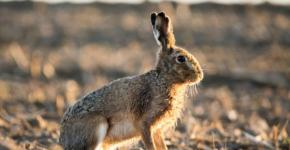Brief description of the bark of trees for preschoolers. "The structure of the tree" in games and tasks
We study the trees. I prepared a material for a cycle of 3-4 lessons designed for children from 3 years old, sharing with you.
I tried several approaches to providing information about trees for Yana. She is now 3.5 years old and it is quite difficult to cause interest in such information. I bring for you a summary of the most successful, in my opinion, option of exploring trees for young children:
Children about trees | Summary of the study of trees with young children
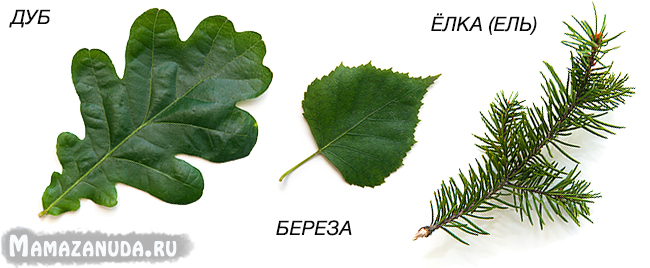
Children about trees | The composition of the set of tasks

Children about trees | Links to useful videos
I share useful links to videos from youtube. In anddeo with accelerated shooting of long processes, such as the life cycle of plants, will help to understand the essence of what is happening to the child much better than all the tasks together:
Tree Growth Fast Shot:
Tree growth qualitative informative animation:
Educational program on the identification of trees | Strange acquaintances - elm, American maple, poplar silver (white)
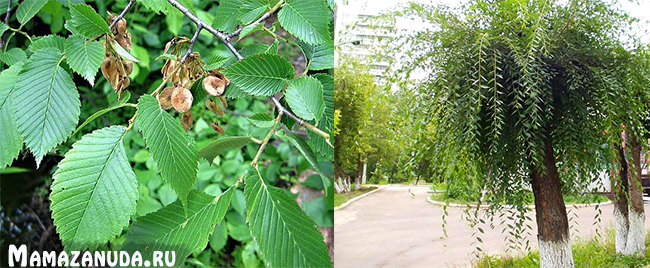
I hope after this educational program you will be able to identify the trees of your yard and teach your children this.
Children about trees | At the end
Another important point is the printing of materials. I once printed materials in the Netprint darkroom. Then I came to the conclusion that photographic paper is not the best option for classes with children. It quickly loses its appearance, and printing is expensive. This year I discovered lamination for myself. I bought a pack of A4 lamination film (such a my-shop) 75 microns thick, I tried it and I was completely delighted. First, after lamination, the picture becomes solid, almost indestructible, and secondly, the costs have been significantly reduced.
Cost calculations. Since I still haven’t bought a printer, printing 1 sheet in color costs me 10 rubles (unless, of course, my friends help me out). Plus the cost of 1 film for lamination - 6 rubles. 4 kopecks We get 16 rubles. 4 kopecks for the color not killed A4 sheet! While printing A4 paper costs about 45 rubles and more per sheet and is a much less durable option. For a very solid color card format 10 by 15, respectively, we get about 4 rubles. If you have a color printer, printing will be even cheaper.
A few words about lamination. It turns out that you can laminate an ordinary iron. The main thing to stock up on a special film. When lamination iron choose low temperatures. I set the temperature control to 1.5 units (about 1/4 of the possible temperature range of my iron). The quality of lamination with an iron depends on experience and cannot be absolutely perfect. Sometimes bumps and folds are obtained. Also be prepared for microscratches from the sole of the iron, they are inevitable with this type of lamination. When the first lamination usually fails. A laminator is required for perfect lamination. At the moment I have adapted to laminating with an iron, since my volumes are small. With the release of the decree, I began to buy more ready-made materials (games, developmental benefits). For a small amount of developing materials, iron lamination is quite enough. I also purchased a figure stapler for corners c Ali to round the corners. In operation, it is not very convenient, cards, laminated with a film of 75 microns, take only when strongly pressed, but it costs a penny, unlike the others.
Another recommendation for working with preschoolers is the book “Who lives in the forest” (Labirint, my-shop, ozon) from the “What? What for? Why?". In one of the moments when I told about the trees, Yana brought it and began to tell me from the memory of how the trees change in the winter period with demonstrations of the corresponding pictures from the book. However, this book in the series is no exception, the whole series “What? What for? Why? ”(
Didactic Cards - Trees
Dear Educators!
I offer you a teaching material for classes. Let's pose nakomim children with different trees.
Print out sheets of trees, their leaves, seeds, and a brief description of each tree. Each tree is accompanied by images of leaves that can be painted. Teach your children to memorize what the twigs, leaves, and fruits look like.
And I also offer you a sample compilation of a small story about a birch (by analogy, you can make the same stories about other trees) and several riddles about trees (read below).
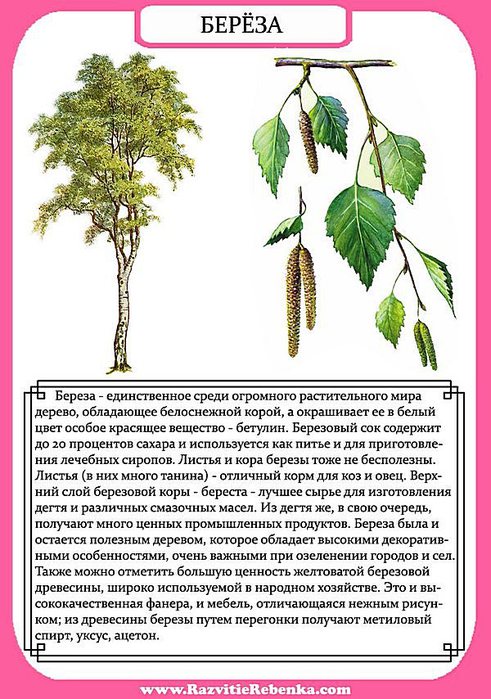
In a brief description of each tree, you can find out their features, how it looks, where it grows, age, interesting facts about the tree.
The story about Birch:
This is birch. She has a white, thin, slender trunk. On the branches leaves are rounded. Birch feeds on roots. Birch is a large deciduous tree. Most often growing in the forest. In the city, people plant birch trees to make the air clean. Various crafts are made from birch bark. In the spring on the birch buds appear, which turn into leaves. Green birch stands all summer. In autumn, the leaves turn yellow and fall off. In winter, bare branches covered with snow.
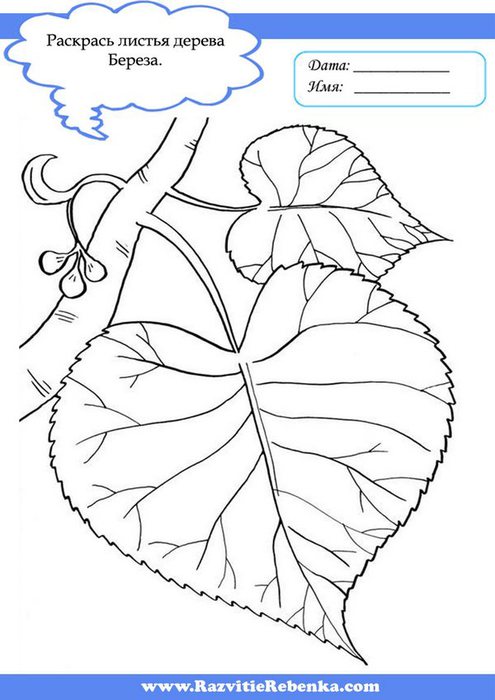
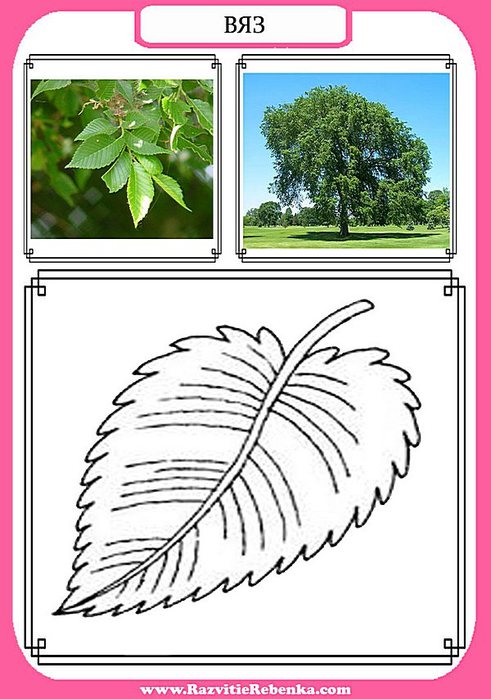

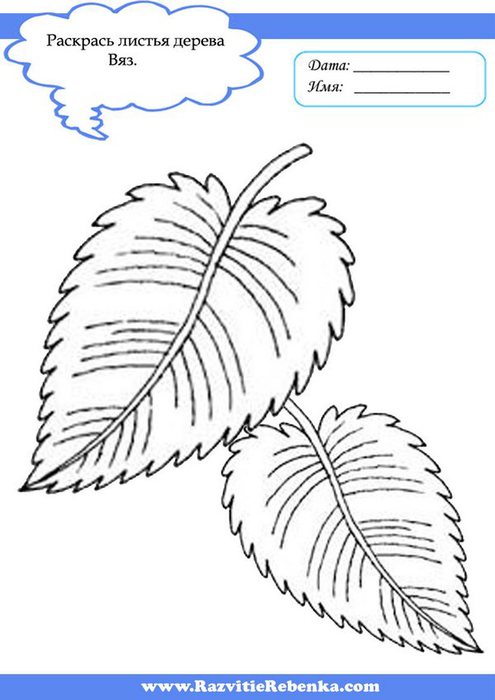
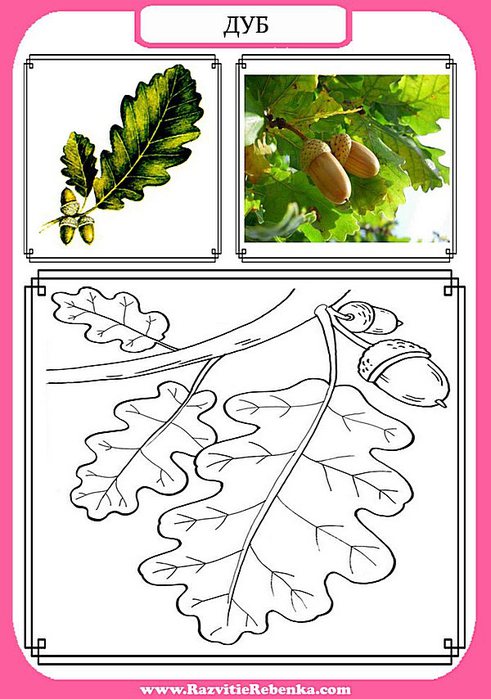

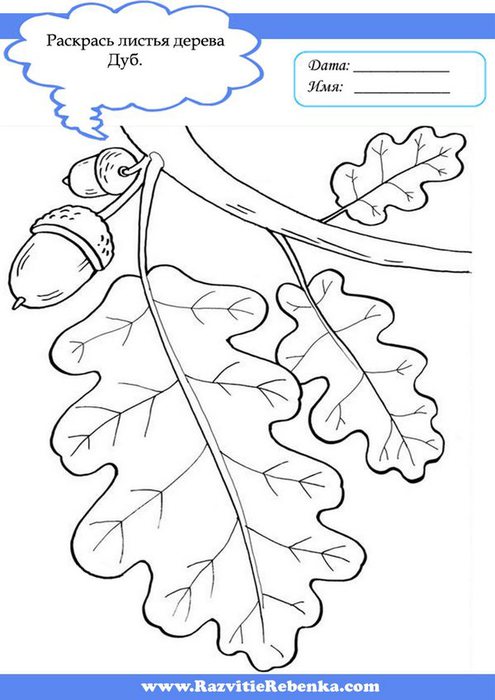

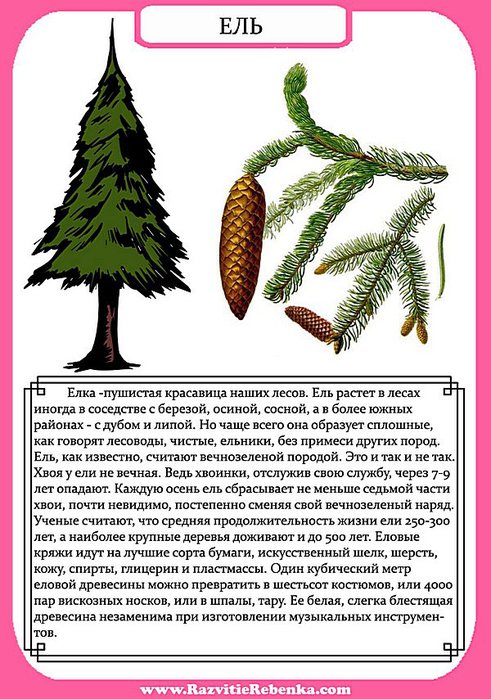


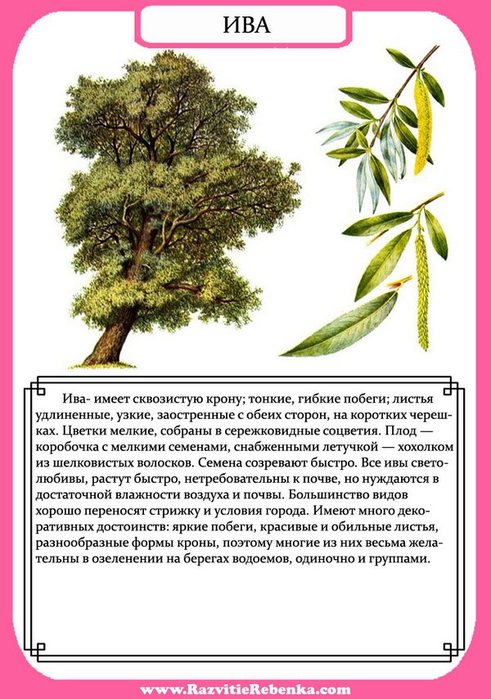
![]()


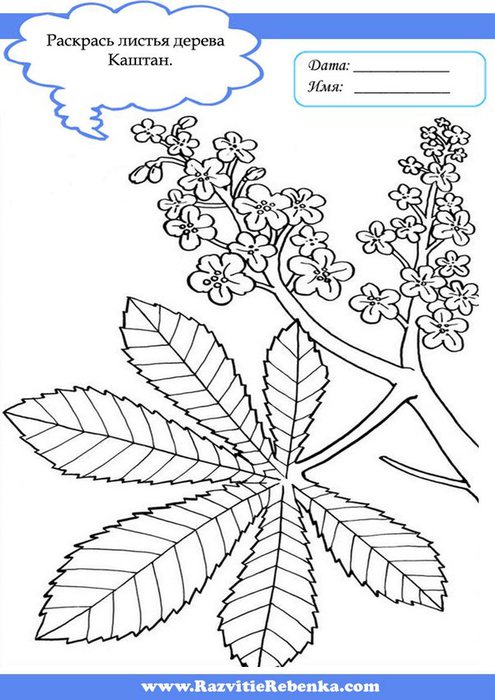
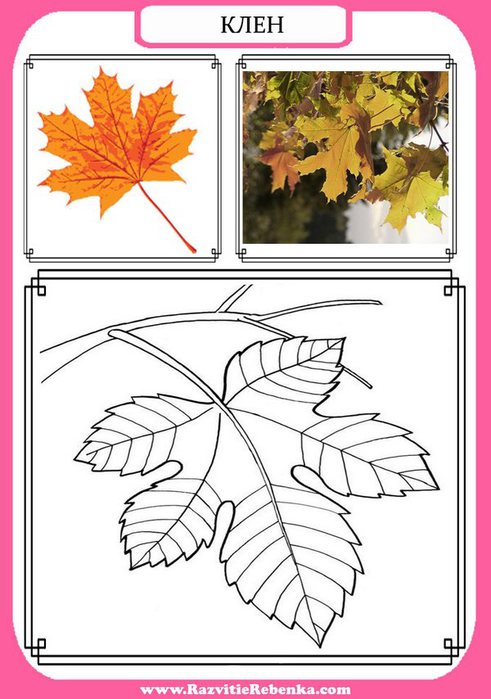

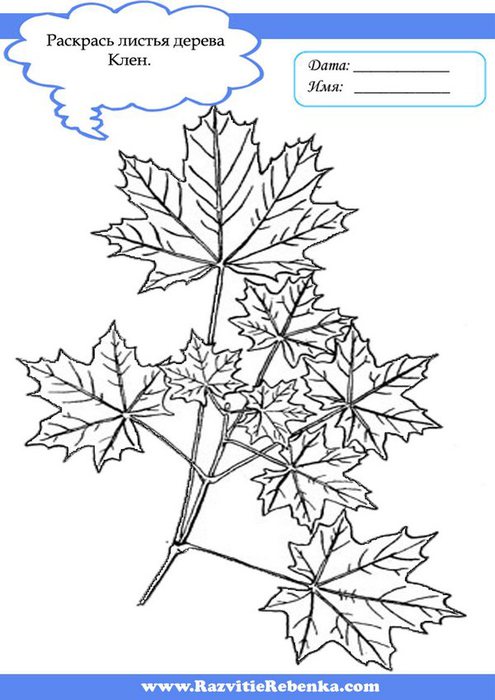
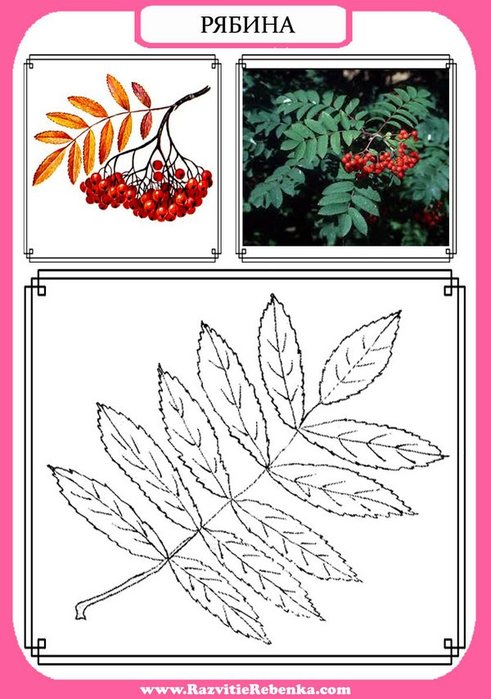
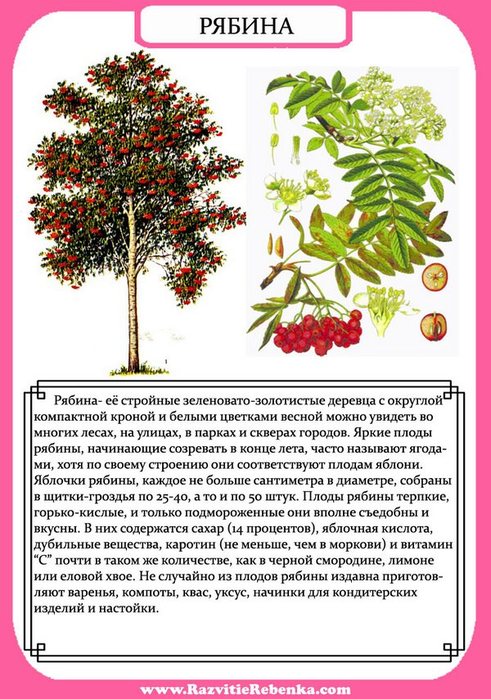

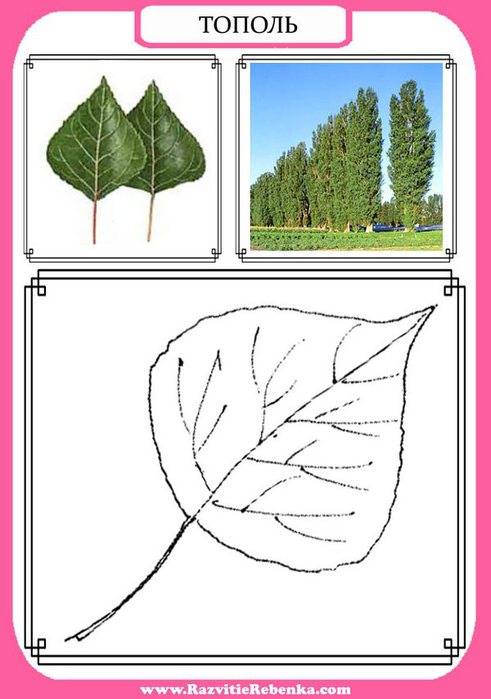

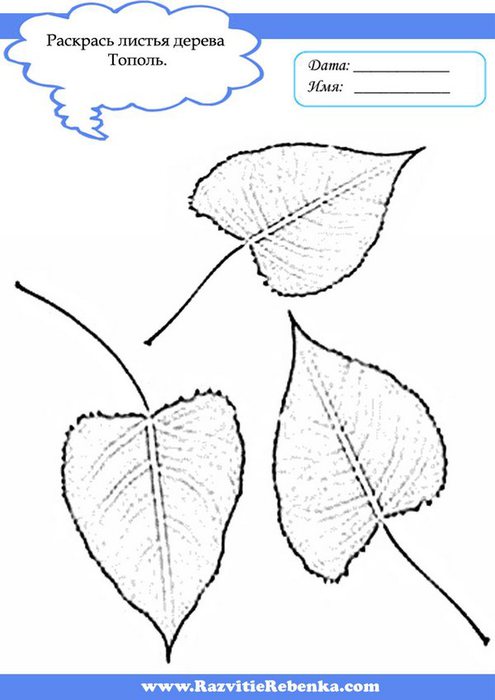
Questions about the Tree:
What trees do you know?
Are trees different from shrubs? Than?
Are trees alive or dead?
Who (or what) helps them grow?
What should they be watered with: water or milk?
(Show pictures of trees) What is the name of this tree? What is the largest? Where is most often growing?
What are the parts?
What benefits can people bring?
How does it change at different times of the year?
What can be made of this tree?
Why do people plant trees in the streets?
What trees are for, use of trees:
Trees purify and moisturize the air, create coolness, some give tasty edible fruits.
A sawn tree is a building material: boards, plywood, furniture, toys, paper are made from dried trunks.
Trees grow slowly, so they need to be protected.
It is necessary to protect the trees, take care of them, sometimes talk with them affectionately, and in the spring together with their parents plant young trees.

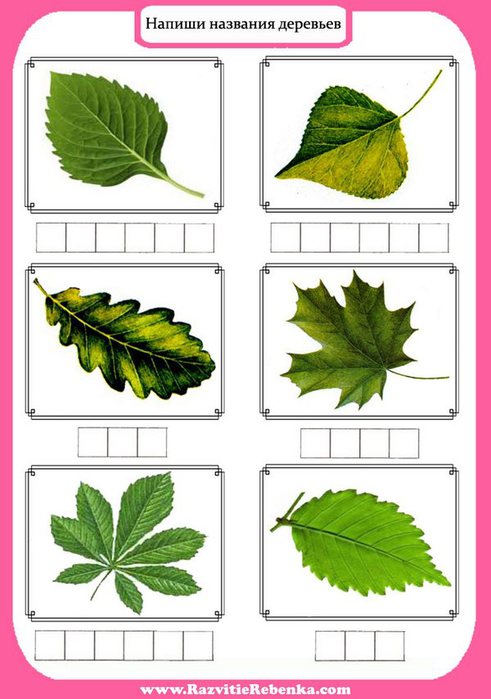
Tasks in which you need to write the names of the trees guessing their leaves.

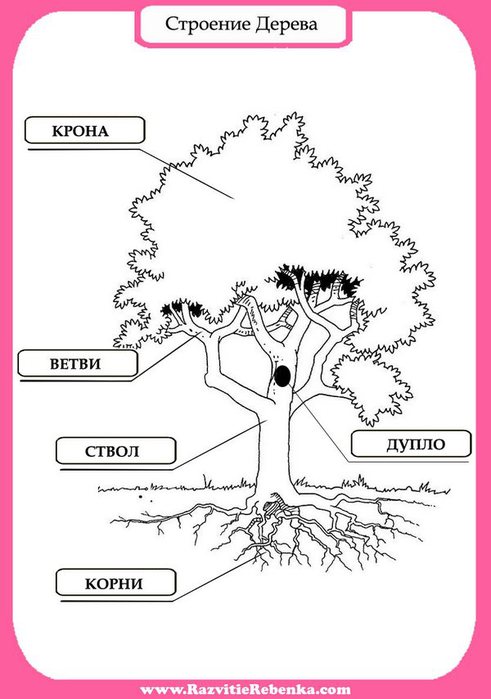
TREE STRUCTURE - a tree with a clearly defined trunk, side branches and apical escape.
The components of the tree are the crown, trunk and roots.
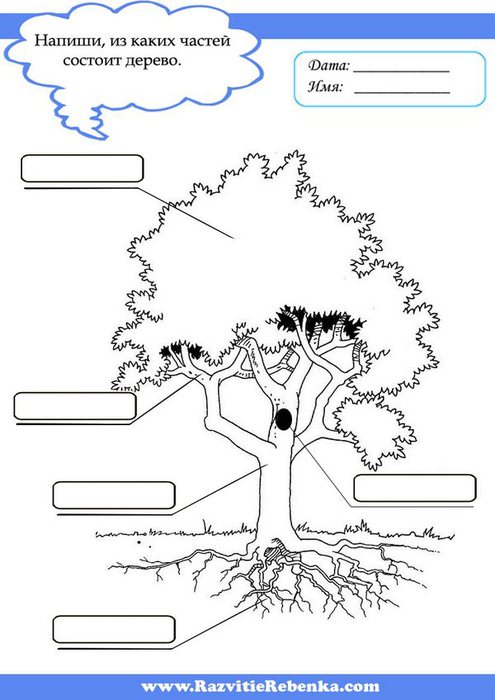
Riddles about Trees:
***
In the spring of fun,
Cools down in summer
Autumn feeds
Winter warms. (Tree)
***
Like pines, like trees,
And in winter without needles. (Larch)
***
Spring green, tanned in the summer,
In the fall put on red corals. (Rowan)
***
Russian beauty stands in the meadow,
In a green blouse, in a white sundress. (Birch tree)
***
Curls lowered into the river
And about something sad
And what is she sad about
He does not tell anyone. (Willow)
***
You will find her in the forest,
Let's go for a walk and meet.
It is prickly, like a hedgehog,
Winter in summer dress. (Spruce)
***
In the summer - snow! Just laugh!
Snow flies through the city,
Why does he not melt? (Fluff from poplar)
***
No one is scared, but everyone is trembling. (Aspen)
1. Consider with the child the poster "Tree Structure"
Considering the poster, have the child find the corresponding parts of the tree with the help of the “Tree Structure” didactic cards. Let the child lay out cards that correspond to parts of the tree, directly on the poster or next to it. Thus, you will not only introduce the child to the structure of the tree, but also develop its attention and logical thinking.
2. Tell about each part of the tree.
Trees are plants. They grow on the ground. Trees grow for many years. Therefore, they are called perennials.
The tree is a perennial plant.
To grow well, the tree needs to drink water. It takes it from the ground with the help of the roots.
To keep firmly on the ground and not to break from the wind - the tree has a solid trunk.
From the trunk branches or branches. From the big branches are small twigs. Leaves and fruits grow on the branches.
Leaves and branches form a crown.
3. Play the Tree Building Game
An adult reads a poem, and the child continues. If the child is at a loss, help him.
What do you know about trees?
They have a mighty trunk.
Branches, twigs and leaves -The wind in the crown found them.
And still big roots go deep into the ground.
Keep the roots of the trunk and crown.
Water under the ground is found.
4. We study the structure of the tree (observations, viewing cards)
Learn the structure of a tree by observing a certain tree while walking or studying cards with a picture of trees.
We study leaves and crown:
- how many leaves are on the tree, what is the crown:
- observation of the shadow of the tree, its movement;
- study leaves;
- kidney research.
We study the bark and trunk:
- what the trunk is covered with;
- width Length;
- what is the crust, what is it for, what is it;
- what smells at different times of the year bark, trunk (in dry weather, after rain);
- whether there are cracks in the tree, hollows, lichens, mosses;
- whether there are traces on the bark left by man;
- Observation of the rings of the tree.
We study flowers (inflorescences):
- the time of appearance of the first flowers;
- how flowers grow on a tree, whether they are clearly visible on a tree;
- than the flower smells when it smells stronger - in the morning or in the evening, in rainy weather or in dry.
We study the roots:
- what keeps the tree in the ground;
- what are the roots in length, whether they come to the surface, what are they for.
We study the fruits and seeds:
- what are they, who carries them;
- what are they needed for.
Studying birds and animals associated with a tree:
- what animals visit our tree (birds, insects, spiders);
- are they well visible on the tree;
- what kind of pets resort to a tree.
5. Fold the puzzle "The structure of the tree"
Collecting the puzzle "The structure of the tree" your child not only develops logical thinking, he learns to make a sequence. A child who is learning to read or is already reading will be able to read the names of the parts of the tree.
6. Secure the child's knowledge about the structure of the tree using the worksheet "Tree Structure"
Cut the bottom of the worksheet, cut the cards with the names of the parts of the tree. Invite your child to stick the cards on the worksheet.
Application for games and tasks:
Poster "Tree Structure"
Puzzle "The structure of the tree"
Worksheet "Tree structure"
In this article about trees you will find pictures, fairy tales, riddles and educational tasks for children. This is the first article from the series "Encyclopedia of trees for kids." And we will get acquainted with three trees in it - oak, elm and ash. At the end of the article there is a presentation for children on the topic “Trees” for free download.
Trees: pictures, fairy tales, developmental tasks for preschool children
Welcome to the wonderful world of trees! I want to believe that you will make new discoveries in this world and love it! And once again admire the beauty and wisdom of nature, revealing its secrets for yourself and for your children.
All tasks are designed for the fact that they will be performed not in “one sitting”, but as the child gets to know the trees. We saw an oak tree on a walk - we talked about it. We looked at the drawing with the leaves of the trees and their bark on the site - for a walk we looked at the bark of the trees in the yard, we drew an individual drawing of the bark of each tree. We looked at the cartoon and came up with a fairy tale on it, etc. Then the child will not just learn new information, but will apply it in life, study the world around us, ask questions, think, look for solutions, grow into an inquisitive, independent, creative person!
I wish you all interesting communication with the world of trees and new discoveries!

Guess a riddle. Why did you decide that this is an oak tree, and not a birch tree or a mountain ash tree?
Task 1. Speech game with coloring "Oak"
Why is oak called a giant? Why is it called long-lived? (because he “lives for a long time”) How else can you say about an oak tree - what kind is it? (Mighty, strong, big, huge, great, branchy, tall, thick, stocky, clumsy, curly, squat, spreading, spreading, thick, age-old, ancient, century-old, stately, majestic, old, young, etc.) .
Useful tips:
1. By picking words, you can play with a child in this game. Print the coloring "Oak". In it the oak crown is divided into parts (10 or more). You can draw a similar picture yourself. As soon as the child calls the word, you paint over one of the parts (it is necessary to paint over quickly - therefore it is better to use a marker). The task is to find a lot of words about oak to paint all the pieces. This task is interesting to the child, and he has a desire to find as many suitable words as possible. I often use this technique in teaching children, and it always gives an excellent result! Gradually, you can divide the image into more and more parts, so children will already be easy to cope with the task.
2. It will be difficult for the child to perform the task to one, therefore you name the most difficult, rare words, and the kid says the words are more simple and familiar. Through such exercises, we enrich the child’s vocabulary and teach him to listen to adults’s speech and the language of works of art, to memorize expressive words, to pay attention to them. If you constantly carry out such word-picking games with your child, you will gradually begin to notice that the child began to use very beautiful, bright, individual, figurative expressions in speech!
3. If you do this exercise with several children or a group of toddlers, you can do it differently. Cut out the colored cardboard leaves (shaped like the leaves of an oak) and attach them to the oak pattern. One word equals one leaf on an oak! It is necessary to calculate so that the leaves at the end of the assignment closed the entire crown. It is very convenient to do such an exercise with the use of Uni patafix - a means for repeated safe gluing of parts. Attached, and then easily removed! No stains, no traces remain, and the pictures are intact! Very convenient in games with children! I have been using it for twelve years and I recommend it to everyone! This plastic mass is sold in stationery stores and online stores.
And here is the coloring for this exercise!

Task 2. Strong, like an oak tree. What does this expression mean?
They say about a strong, strong, healthy person: “He is as strong as an oak tree”. Why say so? Who of the fabulous characters can say so? (Recall heroes from works known to your child. You can tell about Russian heroes from epics or heroes of fairy tales who overcame obstacles and showed their boldness and strength in the struggle with Serpent Gorynych or Koschey Immortal, recall the brave soldier from many folk and author’s fairy tales ). When you watch cartoons or read fairy tales, remember this expression from time to time, ask. about which of the characters can say so, and why.
Task 3. The most seasoned! Watching for a walk
Find an oak for a walk. Consider him, say hello to him.
Tell your child that in the fall, oak leaves fly around reluctantly and slowly, as if they are not in a hurry to fly to the ground. And when the whole forest has already flown around, the oak still has leaves. And some oak leaves do not fly around at all, and remain on the branches for the winter. This is how Irina Tokmakova wrote about this in a poem.
Oak rain and wind
Not at all afraid.
Who said oak
Terrible to catch a cold?
After all, until late autumn
He stands green.
So, hardy oak,
So, hardened.
Find acorns under the oak and view them. Make a riddle.

Task 4. How does a oak grow from an acorn?
Consider the leaves and fruits of the oak tree (explain to the child that the fruits of the apple tree are apples, the pears have pears, and the oak trees have acorns). What color are they? What shape? What do they look like?
Ask the child to guess the riddle (do not show the answer!).

Pay attention to the baby on how interestingly it was said in the riddle about the acorn! “Beretik” in it was called “scoop”, and “box” is what? Why does this riddle say that there is an oak in the “box”, because the oak is large and does not fit in the acorn? (Listen and encourage any opinion of the child, the main thing is that he tries to think, find reasons and interrelations, learns to independently search for a solution in a new situation with an ambiguous answer!)
Ask: “Do you want to know what's inside the acorn and how new young oak trees are made from acorns? Watch this little movie “How an oak grows from an acorn”!
From branch to ground
Plopped acorn
Acorn ripened
The acorn is heavy.
He is scared
Crying and crying
And acorn
A tear does not hide.
- What should I do,
Oak-giant?
Hey, answer,
I'm your son!
- What do you do?
To dig into the ground,
To the spring
In the oak to turn. (Leila Eradze)
To the note: The baby is most likely surprised in the first minute of the film that nothing happens to the acorn. Say that you need to wait a bit and be patient, because the oak from the acorn does not immediately grow. First, the acorn is on the ground for a very long time, getting wet in water in water? it is covered and protected by snow in winter. And only then the first sprout emerges from the acorn, which begins to drag upwards.
Tell your baby that it is possible to grow dunes from an acorn at home if you plant an acorn in damp earth and water it every day. You can try to grow your own oak, if you or your children have a desire. It will be interesting for children - to watch what is happening. Take acorns under a strong strong oak and plant them in ordinary soil for flowers in indoor pots. You can germinate acorns and in wet cotton, and then put in a pot. Water every day, the plant really needs moisture! Ask the baby: “Is there an acorn watering in nature?” (The rain helps him grow!) The sprout will appear no sooner than in three weeks. When the oak tree grows, you can transplant it into the street. Do not throw away the trees after your sprouting experience! They are alive, and the baby must see how they will be returned to nature! Of course, it’s not at all necessary to grow an oak from an acorn, but it always causes delight in children when they see shoots and their development!
Task 5. A playful breeze, or autumn leaves in pictures
Speech exercise on the development of language intuition. Ask the child, start the phrase, and he will finish:
- Oak leaves are oak.
- And aspen? - ... aspen
- Birch? - ... birch
- Do mountain ash? - ... rowan
- Have a maple? - ... maple
- Do poplars? - ... poplar trees
If the child made a mistake, then just say “Such a word could be in Russian, but people call these leaves differently” and name it correctly. The wrong version of the child should not be repeated. Forming new words, the child is in the role of an experimenter-researcher, therefore there are no mistakes here, but let them develop! After all, without falling you will not learn to walk!
Assignment to the child: Once again carefully consider the leaves of the oak. Now try to find them in this picture - confusion. Autumn breeze mixed up all the leaves. Help me figure out where the oak leaves are. And where is the birch leaf? Aspen trees? Maple tree? Rowan berries?
The wind flew through the forest,
Wind leaves counted:
Here is oak,
Here is a maple
Here is a rowan carved,
But with birch - gold,
Here is the last leaf with aspen
Wind threw on the path.
N.Nishcheva

How many oak leaves are in the picture? (Three - one with smoother edges, and two leaves with carved edges)
Note: this and other good quality pictures for printing or on screen are given in the presentation below.
Task 6. What would happen if there were no trees?
“Let's imagine what it would be like if the trees did not become?” (It would be very hot, there would be no shadow, the birds would fly away, the wind would blow, etc.). Try with the child to dream more: “Would you not have the birds?” And why is it bad? Maybe we would have lived without birds? (No, birds peck harmful insects, and then there would be too many of these bugs). “And if there were no trees on our streets, what would be? Would there be a shadow? And what would it be bad? Maybe nothing terrible would have happened? (It would be very hot on the street, very dusty on the road, we would not be able to play during the day in the heat, etc.) After the kid with you speculates and makes his assumptions, let him watch a good cartoon about the boy Nazark, old oak and birch: "Tales of old oak". In this cartoon, the baby will see why we need trees and how they help us!
http://youtu.be/cXqRN5bxFVs
And in conclusion of the conversation about our first tree - the oak, I want to tell you two fairy tales about the oak. The good and the wise are the same as the character of the oak itself - a symbol of strength and wisdom.
Dmitry Chekhov "The Tale of an Old Oak"
In one dense forest lived a wise and old oak tree. He was all respected and called the king of the forest.
Young willows, birches and other trees loved to hear the tales of the old tree.Once an oak tree asked the trees:
- Dear trees - lindens, maples, willows and the rest! - Would you like to listen to a fairy tale
about our forest?
- We want, we want! - All the young trees shouted joyfully.
“Well, listen ...” said the oak.The wise oak tree began to tell:
- In our forest, once upon a time there lived an old and proud stump. This case was in the fall. Once grandmother came to him with a basket, bowed to him and left. After some time, the grandfather comes into the forest with a bag, he also bowed to the stump and left. And so people came with buckets and bowed to the stump.Stop reading a fairy tale here and speculate with the baby, what kind of stump was it that everyone bowed to him? Do we ever stump bow with you? A clue to learn further in the fairy tale - I wonder if you guessed it?
Then the stump became puffy and said to the trees that stood around it:
- I bow to you, I am your king!
But the trees did not bow to him.
- You have a wonderful imagination! said the tall Pine.
- And the gift to play in the theater! - declared wild sweet cherry.
- I am not kidding! - Today, people came to me and bowed to me - you do the same!
But the trees were already outraged:
- How is that? - said the wild apple.
And then a terrible uproar arose. The trees were indignant, and the old stump still argued that he was the king.But then, in the midst of this commotion, a fast tit arrived and sat on a stump. She asked to tell what happened to the wild cherry. When the bird found out everything, she said:
- Old stump! You know that it is autumn in the yard, and that there are a lot of mushrooms in the forest. Look around you.
Indeed, there were mushrooms around the stump: white, boletus, chanterelles and others.
- I now understand why people leaned in front of me! said the stump. - They collected autumn mushrooms! And the old stump no longer boasted, he began to respect all the trees and the forest.Finished telling a wise oak tale.
- What a clever tale! said the owl, who also flew in to listen to the story.
- Indeed, it also happens to us! - admired the young birch.Everyone liked the tale of the wise oak, and since it was in the evening, everyone sweetly fell asleep.
The tale of Hans Christian Andersen "The Last Dream of an Old Oak". Christmas tale
The tale of life is more for adults than for children ... More precisely, not only for children ...
In the forest, high up on the steep, on the open seashore, stood an old-aged oak tree, and it was exactly three hundred and sixty-five years old — a considerable time, but for a tree it’s like that for us humans as many days. We are awake during the day, sleeping and dreaming at night. With a tree, the situation is different: the tree is awake for three seasons and falls asleep only for winter. Winter is the time of his sleep, his night after a long day - spring, summer and autumn.
On warm summer days, mayflies danced around his crown; they lived, fluttered and were happy, and when one of these tiny creatures in quiet bliss descended to rest on a large fresh leaf, the oak always said:
Poor thing! Your whole life is one single day! So short ... How sad!
Sad? - answered the dog. - What are you talking about? Around so light, warm and wonderful! I'm so glad!
Why, just one day - and the end!
The end? - said the dog. - What's the end? You, too?
No, I, maybe, will live thousands of your days, my day stretches the whole seasons! You can't even count how long it is!
No, I do not understand you! You have thousands of my days, and I have thousands of moments, and in every joy and happiness! Well, does the death of all the beauty of the world die with your death?
No, answered the oak. - The world will exist much longer, forever, I can not imagine how long!
So, it means that you and I are equally divided, only we think differently!
And the field girl danced and circled in the air, was delighted with her delicate, graceful, transparent velvety wings, rejoiced at the warm air, filled with the smell of clover, wild rose, elderberry and honeysuckle. And how the woodruff smelled, primroses and mint! The air was so fragrant that it was the time to get drunk from him. What a long and wonderful day was full of joy and sweet sensations! And when the sun was setting, the fly felt such pleasant fatigue, the wings refused to wear it, she quietly sank down on a soft vacillating blade of grass, threw her head down and sweetly fell asleep. It was death.
Poor things! - spoke oak. - Too short they have a life!
And every summer day the same dance was repeated, the same conversation, the answer and falling asleep; this was repeated with whole generations of mayflies, and they were all equally cheerful, equally happy.
Oak was awake its morning - spring, its noon - summer and its evening - autumn, it was time to fall asleep and to him, its night approached - winter.
Here are the storms: “Good night! Good night! Here the leaf fell, there the leaf fell! We cut them off, we cut them off! Try to sleep! We will lull you, we will rock you! Isn't it true how good your old branches are? They ache with pleasure! Sleep sweet, sleep sweet! This is your three hundred and sixty fifth night, because you are still like a one year old baby! Sweet dreams! Clouds pour snow, he will lay down a sheet, a soft veil around your legs! Sleep well, sweet dreams to you! ”
And the oak tree threw off the foliage, gathering in retirement, getting ready to fall asleep, to spend in dreams the whole long winter, to see in a dream the pictures of the experience, as people see them in a dream.
He, too, was once small, and his acorn was his cradle. Humanly, he was now in the fortieth ten. Moreover, there was no more magnificent tree in the forest. Its top was high above all trees and was visible from the sea from afar, served as a sign for sailors. And the oak did not know how many eyes it was looking for. Forest pigeons nestled in its green crown, the cuckoo cooked, and in the fall, when its leaves seemed forged from copper, migratory birds sat down on the branches to rest before setting off across the sea. But now, in the winter, the oak stood without leaves, and it was clear how curvaceous, knobby branches were; the crows and jackdaws took turns sitting on them and talked about how hard it was time, how difficult it would be to feed in the winter.
On Christmas Eve, Oak had the most wonderful dream of his life. Let's listen!
He seemed to feel that the time had come for the holiday, he heard bells ringing around him, he dreamed of a warm, quiet summer day. He spread his mighty green crown widely; sun rays played between its branches and leaves, the air was filled with the scent of herbs and bushes; motley butterflies chased each other; the mayflies danced as if everything existed for their dancing and fun. Everything that from year to year was experiencing and seeing an oak around it, now passed before him as if in a festive procession. He saw horse knights and ladies of past times, with feathers on their hats and falcons on his arm. They drove through the woods, the hunting horn blew, the dogs barked. He saw the enemy soldiers in shiny armor and colorful clothes, with pikes and halberds; they pitched tents and then filmed them. Campfires were glowing, people sang and slept under the widely stretched branches of oak. He saw happy lovers, they met here in the moonlight and cut out the first letter of their names on his spring-green bark. Merry wandering apprentices, it happened - many years, many years after that - hung on its branches zithers and aeolian harps, and now they hung again and sounded again so appealing. The forest pigeons cooed, as if they wanted to tell you what the tree felt like, the cuckoo chunked how many summer days he had left to live.
And now, as if, a new stream of life flowed from the smallest roots to the highest branches and leaves. And it seemed to him that he was stifling, he sensed life and warmth in the roots there, underground, he sensed how the forces come. He grew higher and higher, the trunk quickly, without stopping, stretched upwards, the crown became thicker, fuller, more spreading. And the more the tree grew, the more the joyful thirst grew in it to grow even higher, to rise to the sun itself, sparkling and hot.
The top of the oak tree has already risen above the clouds, which swept below, like flocks of migratory birds or white swans.
Oak saw each leaf of his, as if everyone had eyes. He saw the stars in the middle of the day, and they were so big, brilliant! Each glowed like a pair of clear, meek eyes, recalling other familiar eyes — the eyes of children and lovers who met under his crown.
Oak experienced wonderful, blissful moments. And yet he lacked his forest friends ... He wanted so much that all the other trees, all the bushes, herbs and flowers would rise with him, feel the same joy, see the same brilliance as he did. The mighty oak, even in those moments of blissful sleep, was not completely happy: he wanted to share his happiness with everyone, both small and large, and this feeling trembled in every branch, every leaf, passionately and hotly, as if in a human chest.
The crown of the oak tree was moving, as if searching for something, as if it was missing something; he glanced down and suddenly he heard the smell of woodruff, and then an even stronger smell of honeysuckle and violets, and it even seemed to him that he hears a cuckoo.
And through the clouds peeped green tops of the forest. Oak saw other trees under it, they also grew and stretched upwards; bushes and grass too. Some even pulled out of the ground with their roots to fly faster. Ahead of all was birch; like a white lightning, her slender trunk rushed upward, the branches fluttering like green veils and banners. All forest plants, even the brown reed sultans, rose to the clouds; birds with songs flew behind them, and on a blade of grass, swept in the wind like a long green ribbon, a grasshopper sat and played with a wing on its thin leg. May beetles were buzzing, bees were buzzing, birds were flooded; everything in the sky sang and exulted.
“And where is the red water flower? May he be with us! - said oak. “And the blue bell and baby daisy!”
Oak everyone wanted to see beside him.
“We are here, we are here!” Came from all sides.
“And the beautiful last year's woodruff? And the carpet of lilies of the valley that spread out here a year ago? What about a wonderful wild apple tree and all those who decorated the forest for many, many years? If they had lived to see this moment, they would have been with us! ”
“We are here, we are here!” Rang out high, as if the respondents had flown right over him.
“No, how good it is, just can not believe it! - exulted old oak tree. - They are all here with me, both small and large! None is forgotten! Is such happiness possible? ”
“Everything is possible!” - sounded in response.
And the old oak tree, which did not stop growing, suddenly felt that it was completely separated from the earth.
“Nothing could be better! - he said. - Now, I do not hold any ties! I can fly to the very source of light and brilliance! And all my dear friends with me! Both small and large - everything! ”
That's what the old oak tree had dreamed of. And while he dreamed, a terrible storm raged over the land and sea — it was on Christmas night. The sea rolled ashore heavy trees, the oak creaked and cracked and was pulled out with roots at that very moment when he dreamed that he was separated from the ground. The oak tree collapsed ... Three hundred and sixty-five years of his life are now one day for the mayfly.
On Christmas morning, when the sun rose, the storm subsided. Festively the bells rang, from all the pipes, even from the pipe of the poorest hut, blue smoke curled up like a sacrificial incense on a Druid festival. The sea calmed down more and more, and on a large ship that withstood the night storm, they lifted elegant Christmas flags.
And there is no tree anymore! Night storm crushed the old oak, our mark on the shore! - said the sailors. - Who will replace us? No one!
This is what a gravestone speech, brief but said from a pure heart, was honored by the sailors of the old oak tree, which had been stormed into the snow cover. Reached the oak and the old song, singing sailors. They sang about Christmas, and the sounds of the song ascended high up towards the sky, as the old oak rose in its last dream.
2. Elm in pictures and tasks for children
Elm is often found on our streets. This is a very useful tree - it cleans the air wonderfully. And the elm is very fond of birds - they peck its seeds.
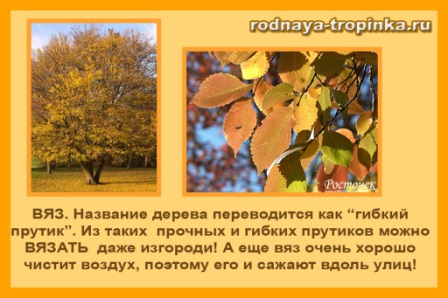
Task 1. Parts of the tree. Why bark trees?
Ask the child: “What parts does the tree have? (Root, stem, branches, leaves, buds open in spring, there are flowers, then fruits). Why does a tree need bark? Bark for a tree as for us - clothes. Why do we need clothes? (It warms us, protects from cold, heat, mosquitoes and midges). So the bark of trees protects them in the winter instead of our fur coats and hats. And in the summer it protects from heat, insects, dust, water. Without bark, the tree dies or is sick. ”
The northern and snowy wind rushes towards them.
- Where are the trees, your clothes?
Where are your hats and mittens?
No matter how cold you get a cold!Will fall snowdrifts, will not become paths,
It will be cold to you without shoes.
Iced branches and roots.
Who will feed you? Who will give you a drink?
(L. Stepanov)
The bark does not always have the trees. Southern trees may not have bark - they are already warm, because in the south there is no cold winter!
Task 2. Bark Pattern
Each tree has its own bark pattern. You can even draw it. To do this, take for a walk a sheet of paper and a soft simple pencil (the softer - the better it will turn out!). Put a piece of paper on the bark and hold it tightly, and let the baby gently strokes the surface of the paper. The paper will have a bark pattern. You can paste it into an album about different trees, and next to the pictures of the bark, you can paste photos of trees and their dried leaves.
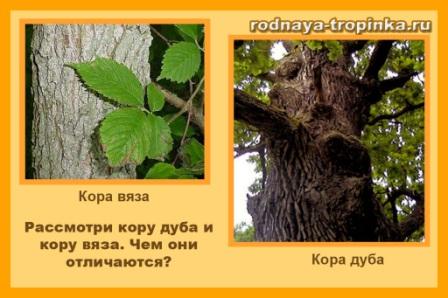
Task 3. Leaves and Seeds
Ask the child: “Why do trees need seeds?” Explain that new trees are obtained from the seeds. The seeds of the trees are light and fly with the wind very far. There they fall to the ground and germinate, and from them a beautiful new tree is obtained. Look at the light, almost transparent elm seeds.
On the walk, find elms and show the child. Look carefully at the leaves under the tree and find "from which branch these children", that is, where are the leaves of the elm tree, and where are the leaves of other trees. Do not tear off the leaves for viewing! The tree is alive!
Ask: "Why do trees need leaves?" Allow the child to touch the leaves, run his finger along their contour, on the surface of the leaf. Let the child touch the tips of the leaves - what are they: sharp or dull? Which edge is serrated, carved or even?
Discuss where the leaves will disappear in the spring? After all, there are a lot of them on earth now? But in the summer they are not! In the forest, nobody leaves the leaves. Where are they? Tell that the leaves are very necessary for the soil, the earth, they give it nutrients. If the leaves are removed, the soil becomes poor and depleted. Therefore, the autumn carpet of leaves on the ground should be preserved as it occurs in nature in the forest. In the spring, it will be possible to look for old leaves on the ground and show the kid how they turn into very dark, and then completely black.
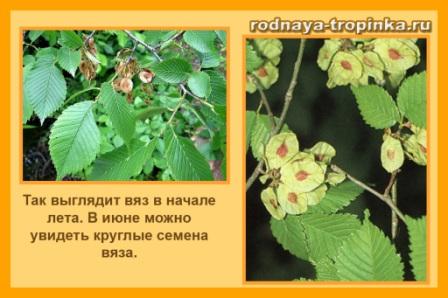

3. Ash in pictures and tasks for children
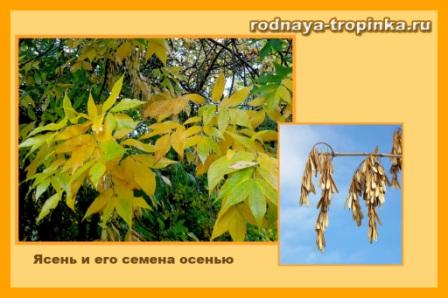
How are you slim and beautiful
our native high ash!
Decoration of wood,
how are you green and shady!
Up to fifteen leaves
form a complex sheet.
Yu. Nasimovich
Task 1. Why is ash so called?
Ash has a very beautiful name: ash. And before that it was called an ash-tree, an ash tree, and even an ash tree. What word do all these words look like? The word "clear." Why is ash so called? The secret is in its leaves.
Let's look at the leaves of ash. They are very similar to the leaves of the mountain ash. What do they look like?
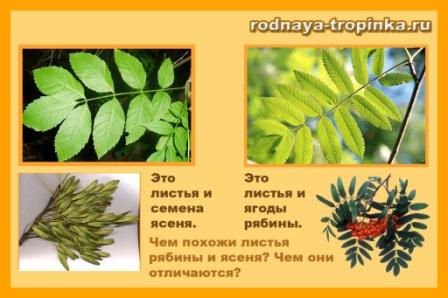
And how do they differ? (The rowan leaves are narrower and more carved. And the ash leaves are wider than those of the rowan)
Ash has rare leaves, there are gaps between them. Therefore, he has a light, openwork, light crown of leaves. That is why it is called “clear” - “ash”.
Ash is an amazing tree! Its leaves fall in late autumn and often fall straight green to the ground. Listen to the tale of why ash does not flaunt a long fall in a gold outfit, but throws it off quickly, even with green leaves:
The Tale of Ash
So spring has come, all the trees and bushes have been removed with beautiful leaves and bright flowers.
Ash alone stands naked like a cold winter. He deprived his god of sight, and the poor fellow did not know that spring came and brought joy to everyone.
Birch has long woven its hard-core, heart-shaped leaves, beautiful toothed leaves have long been prepared by the oak. Ask the trees why not sew the ash of the holiday attire?
Did spring come? - Ash was surprised.
Spring has come long ago, the trees told him.
Here ash began to hastily prepare his own holiday outfit — foliage. But in a hurry he could not make the leaves smooth and beautiful, but they turned out angular, with deep notches.
In autumn, when the north wind blew, asked ash trees:
Is autumn coming soon?
Yes, she is already here, - the trees answered.
Heard this ash, and did not want him to again be a laughing stock for all. So he threw off all his foliage at once. Other trees are still lushly leafed, and blind ash stands naked, and the north wind rages in its branches.
And ash is called "goat tree." How do you think why? Its leaves are very fond of sheep, goats, and from feeding the leaves with ash leaves, milk from goats becomes more delicious!
Ash is a tree that likes to be friends with other trees - with elm, with maple! And it is very often friendly with oak - it grows side by side with it.
And children are friends with ash. They love to make crafts and toys from his seeds.
Task 2. What happened in the forest? Make up a story
What happened to the maples?
Threw crowns.
And tall oaks
As if reared up.
And Hazel itself is not his
Rustles thick foliage.
And the ash is whispering faintly:
Disagree, disagree!
What happened in the forest? What do you think is the name of this poem? Why did the trees suddenly speak? What were they talking about? If the child is interested, you can write a fairy tale “What did the trees say?” Together with him and draw pictures to her. And this poem is called “The Wind in the Forest,” wrote Agniya Lvovna Barto.
Task 3. Ash Seeds

Birds are friends with ash. In winter, they often sit on the branches of ash. How do you think why? What attracts them? That's right, the seeds! Look, with what pleasure the bullfinch pecks the winter ash seeds! This is his lunch!
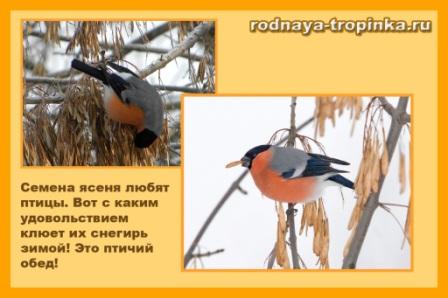
That ended our first journey into the world of trees! See you again at the “Native Path!”. Pictures of this article in high quality and good resolution in the form of a presentation you can download in our Vkontakte group “Child development from birth to school” (see the section of the “Documents” group under video recordings of the group). The presentation can be edited.
Presentation "Trees in pictures and tasks for children"
Presentation with pictures on the topic "Trees" for games and activities: you can download for free
And in conclusion, two laughs from the little reader Native path. They were sent to us by Misha's mother.
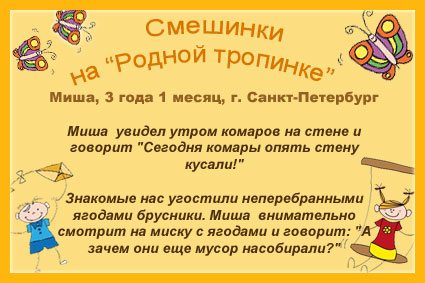
Get NEW FREE AUDIO COURSE WITH GAME APP
"The development of speech from 0 to 7 years: what is important to know and what to do. Cheat sheet for parents"
Click on or on the course cover below for free subscription
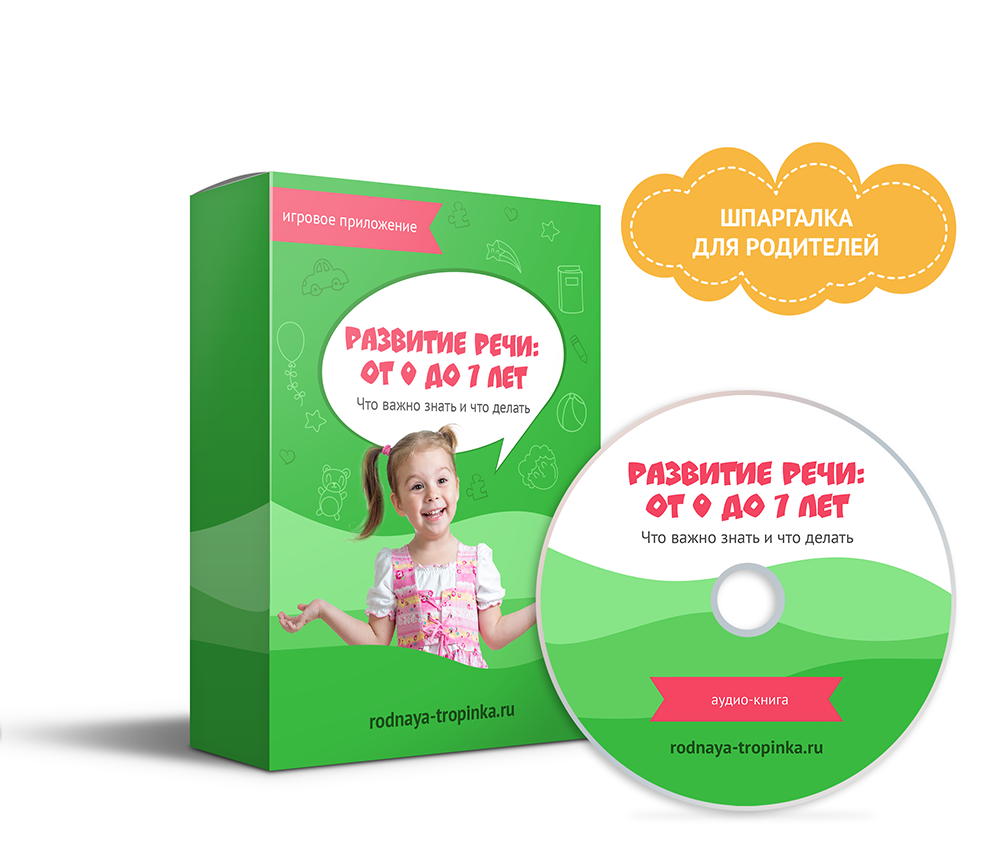
What are the trees, what are they and what are they for?
Trees purify and moisturize the air, create coolness, give fruit. Cut trees are a building material and raw material: boards and paper are made from dried trunks.
Trees are wild: birch, oak, spruce, willow, chestnut, maple, linden, aspen, aspen, alder, pine, poplar, ash. Such trees grow in parks, along roads, in the forest.
More trees are fruit: apple, pear, cherry, apricot, plum, plum, mountain ash. Such trees are grown in the garden, because they give delicious edible fruits.
In the tree there are three main parts: root, stem and crown.
The root of a tree is usually the underground part of a plant. Thanks to the root, the tree is provided with nutrients from the soil.
The trunk of the tree serves as a support for the crown, and also transfers substances between the roots and the crown. Outside the trunk is covered with bark.
The crown of a tree is a collection of branches and leaves in the upper part of the plant. In the fall, the leaves of many trees acquire yellow, orange and red hues and fall from the trees. But there are also evergreen trees, such as spruce and pine.

Each tree has its own distinctive features.
Birch tree - This is a tree with a white, thin, slender trunk. Birch inflorescences are called birch earrings. In the spring, birch sap is obtained from birch.
Oak - This is a powerful tree, forest long-liver, has rounded leaves and a very lush crown. Oak is well recognizable due to its acorns.
Maple - It is a tree with beautiful leaves, in the autumn its colorful leaves are the decoration of any park. The fruit of a maple is called a two-winged dragon: after ripening, it breaks into two halves (lionfish) that fly through the air and carry the seeds.
Apple tree - the most common garden tree. It is very unpretentious and it survives well even where other fruit trees cannot grow. There are many varieties of apple trees. Apple fruits are apples, they are very useful.

So that the child confidently remembers not only the names of the trees, but also their appearance, print out their images from the Internet, cut them into pieces and offer to assemble a mosaic. On the eve of any summer walk, study in an encyclopedia or on Wikipedia an image of the leaves of one tree alone and find at least five trees with the same leaves for a walk. Repeat these lessons every year, studying the appearance of familiar trees at different times of the year. Explore what seeds the tree propagates in the spring, whether the flowers bloom on it, what its autumn leaves and bare branches look like in the winter. Knowledge of trees will enrich the child’s vocabulary and broaden their horizons.

